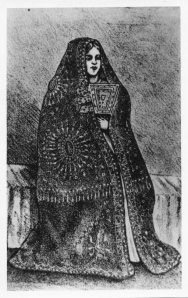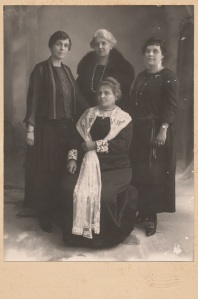MYSTERY
♦
Tea and scandal: The case of the missing Abyssinian wedding cloak
♦
Background to the case:
In the early 1840s John Bell, a young Englishman born in Malta, entered Ethiopia, a land known to his generation as Abyssinia. His friend, Walter Plowden, accompanied him and together they planned to discover the source of the Nile.
By the end of 1860 both men were dead. John, or Johannes Bell as he became known, gave his life in service to Emperor Tewodros who had bestowed on him the rank of liqä mäkwas.
It is said that John and the Emperor become such great friends that following John’s death, Tewodros took charge of John’s family.
John and his Ethiopian wife Woisero Worknesh Asfa Yilma had three children, a son Aligas, also known as John, and two daughters. Both girls married Europeans in the Emperor’s service. First, the eldest Jewubdar, known as Susan, married Theophilus Waldmeier and later, Beletetch, known as Mary, married Karl Saalmüller. On each occasion Tewodros gave the brides a royal wedding cloak and to the grooms he presented gold embroidered saddles along with harnesses and silk shirts and trousers.
♦
Unnamed artist
Illustration of Woisero Beletetch in her royal cloak
undated
(gelatin silver or bromide print)
13.0 x 8.0 cm (image), 13.8 x 8.8 cm (sheet)
Private collection, Melbourne
Initial evidence:
In 1966, Beletetch Mary and Karl’s daughter Stefana Armbruster published a book titled Life and history of John Bell and his descendents. Stefana’s book is to a large degree an anthology. The wedding cloak given to her mother is discussed in two separate sections. The first occurs on page five as part of a wide-ranging introduction. Preceding this mention is a black and white portrait illustration (pictured above). In the book it is captioned, ‘Woisere Belletech in her royal cloak’. The second mention, on page fifteen, occurs in a reproduction of her mother’s obituary written in 1936 by Marshal N. Fox.
This marriage took place shortly after the death of her father
John Bell … King Theodore, therefore took her father’s place
in giving Mary Bell away at the wedding and also gave her a
royal cloak, richly embroidered in gold and fastened in front with
a large solid gold clasp. Her daughters have a lovely portrait of
their mother dressed for the wedding ceremony in this cloak.
It is now in the Dresden museum.
♦
Umberto Benedetti
Beletetch Mary Bell Saalmüller in her wedding cloak
undated
gouache on paper
34.2 x 25.0 cm (image), 40.9 x 30.5 cm (mount)
Private collection, Melbourne
The plot thickens:
As the twenty-first century dawned, Mary Beletetch Bell Saalmüller’s great great grandaughter stumbled across a painted portrait of her ancestor. The reverse bore a detailed inscription and she remembered reading something similar her grandaunt’s book some years earlier.
With the internet as a research tool, and email providing a means of contacting specialists, the search for the wedding cloak began. Sadly there was no institution called the Dresden Museum to be found. Undeterred, she plodded on, an amateur detective, hot on the trail and armed with a colour depiction of the missing cloak.
(detail) pen and ink inscription on reverse of gouache painting
Curators were helpful, but could find no such cloak in their collections. Their databases had no record of the surnames of the most likely donors; Bell, Saalmüller, Armbruster, Little or Bonfils. They recommended consulting various scholars – these were duly contacted but to no avail. It was time to reassess the known factors.
The issue of which museum might house the cloak had already reared its head. The question of when it had been donated now emerged as a key issue. Revisiting Stefana’s book, it became apparent that it was unclear whether Mary’s daughters had donated the cloak to ‘the Dresden Museum’ after her death or, whether Mary herself had donated it during her lifetime.
If the former, then the cloak should have been held in a German, if not Dresden collection at the time Stefana’s book was published in 1966. If the latter, then the cloak must have been donated before 1936. This proposition posed a new and unhappy problem.
What if the cloak had been lost or destroyed?
♦
Jules Lind, Beyrouth & Smyrne
Beletetch Mary Bell Saalmüller with three of her daughters:
Stefana Armbruster, Wega Little and Marielie Bonfils
(1920s)
gelatin silver print
22.0 x 16.4 cm (image and sheet), 29.5 x 19.5 cm (mount)
Private collection, Melbourne
The trail goes cold:
During the Second World War, bombing decimated large parts of the city of Dresden and its surrounds. Many artworks were removed to places of safekeeping however the likelihood of an nineteenth century Ethiopian wedding cloak being deemed of sufficient value, either monetarily or in cultural heritage terms, to warrant such a move was low.
The search for the wedding cloak had reached a dead end.
It seemed that no major institution – one that could be considered a modern day equivalent of the so-called Dresden Museum – held such a piece in its collection. Furthermore, if the cloak had been removed to a remote location during the bombing of Dresden, it seemed there was no record of where it had been sent.
♦
It remains possible that the cloak survives in a German collection however not every institution with a costume and textile collection can identified and contacted, nor every curator, registrar and scholar pestered. The location of the cloak is, for the time being, unknown with only these gouache and photographic pictures to attest to its existence.
by Pat Little
14 August 2011
♦
If you think you know the whereabouts of this mystery cloak, please leave a comment.
♦
Copyright ownership of post and page entries is retained by the author
♦





Hello Tandscandal,
I like your idea of reading into old photographs, i personally find them fascinating too….
This is a wonderful mystery, and cries out to be written as a fictional piece–perhaps a children’s book? Thank you for sharing this story, and the wonderful illustrations showing the cloak.
There was a story on the BBC website recently about Dr. Oetker, a well-known German food supplier, handing back artworks from their private collection. http://www.bbc.co.uk/news/business-41000756 . If there is going to be a more widespread handing back of items currently held in corporate collections, maybe there is hope that the cloak will come to light as part of that process ?
[…] MYSTERY […]
[…] MYSTERY […]
John Bells father was my Relative, I find this fascinating
Hi Tracy, thanks for reading.
You may find the latest episode of The Stuff the British Stole podcast interesting also. pod.fo/e/18b6fa
‘The Unfinished Prince’ is about about Prince Alamayu and what happened to him after his parents died and he was taken from Ethiopia to England.
Worknesh and John Bell’s daughters left Ethiopia with their husbands and daughters at the same time. When Worknesh and John’s eldest granddaughter Rosa turned five, Alamayu’s father Tewodros suggested the children would one day marry.
Yes I find it all very interesting
My link is Thomas william Bell from Grenada . John Bells Brother , the stories are fascinating as I am a direct decendant ,my father is Allan David John Bell , his father Allan Hugh Bell and his father ,Joseph Hugh Bell , my great , great Grandfathers are part of me , I find that fascinating